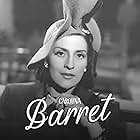IMDb RATING
6.8/10
847
YOUR RATING
Two doctors make a pact in which they swear that the first to die will return - if possible - to tell the other how to get a glimpse of the afterlife while still alive.Two doctors make a pact in which they swear that the first to die will return - if possible - to tell the other how to get a glimpse of the afterlife while still alive.Two doctors make a pact in which they swear that the first to die will return - if possible - to tell the other how to get a glimpse of the afterlife while still alive.
Gastón Santos
- Dr. Eduardo Jiménez
- (as Gaston Santos)
Mapita Cortés
- Patricia Aldama
- (as Mapita Cortes)
Luis Aragón
- Dr. González
- (as Luis Aragon)
José Loza
- Amigo de Eduardo en café
- (uncredited)
Velia Lupercio
- Mujer entierro
- (uncredited)
Jesús Rodríguez Cárdenas
- Enfermero
- (uncredited)
Antonio Sandoval
- Representante de autoridad
- (uncredited)
Guillermo Álvarez Bianchi
- Don Anselmo
- (uncredited)
Featured reviews
I couldn't think of a place more far-removed from the dreary streets, Gothic cathedrals, stone gargoyles and misty back-alleys that have come to be associated the Gothic horror sub-genre, than Mexico. Yet here we have a pure Gothic story told in the most traditional of ways. Fernando Mendez throws everything and the kitchen sink in the mix, from disfigured monsters and a madhouse to spectral ghosts and atheistic scientists and I'm happy to report that it works far better than one would expect from a Mexican b-movie without it becoming picturesque or unintentionally comedic. The only fault that I find with Misterios de Ultratumba (other than failing to deliver promised black pits) is that it doesn't try to push the envelope. It's content to be a very traditional Gothic horror picture with a simplistic story. If it weren't for some impressive stylistic flourishes (like the gallows scene for instance) and the creepy atmosphere, one could be forgiven for totally dismissing it as a "seen-better" case. As it is, fans of 30's Universal horror and Hammer from around the same time will probably like it.
Despite my satisfactory encounter with EL VAMPIRO (1957) a few years back, this is still just my second Mexican horror film of its vintage!
Given a complex and fascinating plot to work with - which has only the briefest concession to camp and, uncharacteristically for a horror film, is teeming with male protagonists (five, while there are only a couple of females of any importance) - a balance is reached between its intended literariness and the trademarks of the genre: foggy atmosphere, evocative décor and a bombastic yet effective score. The presence of Dr. Aldama's ghost is quite subtly but effectively established; besides, both Dr. Masali's expressionistic execution scene and the surreal first encounter between the two young lovers are stylishly realized - while the vicious attack of the manic woman and Elmer's resurrection emerge, perhaps, as the film's horror highlights. Furthermore, we get vividly essayed portrayals by the suave Ramon Bertrand as Dr. Masali and Carlos Ancira as Elmer - the latter, a cross between Dwight Frye and Peter Lorre (and helped by some splendid make-up), could well give the classic monsters a run for their money!
Though Masali and the young doctor (played by Gaston Santos) both vie for the girl's affection, there is very little rivalry between them let alone plots for revenge - as the film stresses Dr. Masali's single-mindedness in his search for knowledge regarding the afterlife. The asylum setting - and especially the imagery of outstretched hands through the bars of the cells - recalls BEDLAM (1946), while the hypnotic effect the music box has on the mad gypsy woman brings back memories of Bunuel's Mexican black comedy THE CRIMINAL LIFE OF ARCHIBALDO DE LA CRUZ (1955); also the scene where Masali/Elmer is discovered strumming on the violin is reminiscent of the Ape Man at the piano in RETURN OF THE APE MAN (1944)! There is one flaw with regards to the plot, however: it's inconceivable that, even if Masali was discovered locked in with the woman's corpse, no one suspected Elmer of having killed her for disfiguring him! Other amusing flubs include the scene in which the 'monster' - engulfed in flames - pauses to open a door before exiting a room screaming, the fact that the gypsy is able to effortlessly hurl a massive cupboard at the asylum orderlies confronting her, and the shot - accompanied by a histrionic single note on the soundtrack - early on where Dr. Aldama's coffin is opened prior to burial, almost as if to assure us that it is he...but, other than that, this particular sequence is comparable to the opening moments of James Whale's FRANKENSTEIN (1931)!
The DVD transfer is imperfect but not intrusively so, apart from some persistent hum on the soundtrack. The supplements are extensively researched and highly interesting (in particular, the Audio Commentary); the still gallery suggests that it's possible that some asylum footage has gone missing as it features a hulking, chained-up character who isn't seen in the actual film! Also, given that THE BLACK PIT OF DR. M wasn't released in the U.S. by the notorious K. Gordon Murray, the information imparted about him here isn't really pertinent to this release - though I didn't mind having it in the least, being all new to me; in fact, the English-dubbed version is, for all intents and purposes, deemed lost - even if Casanegra attempted to make amends by presenting the full-length English translation via a copy of the script (in rather too miniscule a font to be easily legible!) prepared for U.S. consumption.
As with the same director's EL VAMPIRO (which is upcoming on R1 as a 2-Disc Set accompanied by its sequel THE VAMPIRE'S COFFIN [1958]), then, this one emerges as a genuine classic of the horror genre and one that should be much better known. This viewing has kicked off my proposed Halloween marathon in a big way; I'm very much looking forward now to the rest of the Mexican titles which are coming up this week - but it has also made me yearn to check out the other films mentioned in the various supplements and which have yet to see the light of day on DVD...
Given a complex and fascinating plot to work with - which has only the briefest concession to camp and, uncharacteristically for a horror film, is teeming with male protagonists (five, while there are only a couple of females of any importance) - a balance is reached between its intended literariness and the trademarks of the genre: foggy atmosphere, evocative décor and a bombastic yet effective score. The presence of Dr. Aldama's ghost is quite subtly but effectively established; besides, both Dr. Masali's expressionistic execution scene and the surreal first encounter between the two young lovers are stylishly realized - while the vicious attack of the manic woman and Elmer's resurrection emerge, perhaps, as the film's horror highlights. Furthermore, we get vividly essayed portrayals by the suave Ramon Bertrand as Dr. Masali and Carlos Ancira as Elmer - the latter, a cross between Dwight Frye and Peter Lorre (and helped by some splendid make-up), could well give the classic monsters a run for their money!
Though Masali and the young doctor (played by Gaston Santos) both vie for the girl's affection, there is very little rivalry between them let alone plots for revenge - as the film stresses Dr. Masali's single-mindedness in his search for knowledge regarding the afterlife. The asylum setting - and especially the imagery of outstretched hands through the bars of the cells - recalls BEDLAM (1946), while the hypnotic effect the music box has on the mad gypsy woman brings back memories of Bunuel's Mexican black comedy THE CRIMINAL LIFE OF ARCHIBALDO DE LA CRUZ (1955); also the scene where Masali/Elmer is discovered strumming on the violin is reminiscent of the Ape Man at the piano in RETURN OF THE APE MAN (1944)! There is one flaw with regards to the plot, however: it's inconceivable that, even if Masali was discovered locked in with the woman's corpse, no one suspected Elmer of having killed her for disfiguring him! Other amusing flubs include the scene in which the 'monster' - engulfed in flames - pauses to open a door before exiting a room screaming, the fact that the gypsy is able to effortlessly hurl a massive cupboard at the asylum orderlies confronting her, and the shot - accompanied by a histrionic single note on the soundtrack - early on where Dr. Aldama's coffin is opened prior to burial, almost as if to assure us that it is he...but, other than that, this particular sequence is comparable to the opening moments of James Whale's FRANKENSTEIN (1931)!
The DVD transfer is imperfect but not intrusively so, apart from some persistent hum on the soundtrack. The supplements are extensively researched and highly interesting (in particular, the Audio Commentary); the still gallery suggests that it's possible that some asylum footage has gone missing as it features a hulking, chained-up character who isn't seen in the actual film! Also, given that THE BLACK PIT OF DR. M wasn't released in the U.S. by the notorious K. Gordon Murray, the information imparted about him here isn't really pertinent to this release - though I didn't mind having it in the least, being all new to me; in fact, the English-dubbed version is, for all intents and purposes, deemed lost - even if Casanegra attempted to make amends by presenting the full-length English translation via a copy of the script (in rather too miniscule a font to be easily legible!) prepared for U.S. consumption.
As with the same director's EL VAMPIRO (which is upcoming on R1 as a 2-Disc Set accompanied by its sequel THE VAMPIRE'S COFFIN [1958]), then, this one emerges as a genuine classic of the horror genre and one that should be much better known. This viewing has kicked off my proposed Halloween marathon in a big way; I'm very much looking forward now to the rest of the Mexican titles which are coming up this week - but it has also made me yearn to check out the other films mentioned in the various supplements and which have yet to see the light of day on DVD...
I remember years ago, I saw this movie at a drive-in in Portland, Oregon. However, I thought the title then was "The Black Pit of Dr. X," and it was in English. I remember the part where the disfigured doctor returns from the grave and starts to play his violin. At that point I left the theater. Ever since, I've wanted to see it again to know how it ends. So there was at one time a print of this movie in English. Whether it is available now is another question. If anyone knows of an available copy (in English or Spanish), I would be interested in checking it out. I would also be interested to know if anyone has seen it recently (within the last few years) and where he/she saw it. Thank you.
Movies and TV from the Buffy show all the way back to 1960 have been ripping off the dig-myself-out-of-the-grave scene, evidently begun with this film (correct me if I'm wrong). The idea could be as old as Poe but it's this film which, in my history, succeeds with the definitive version. As mentioned earlier, two doctors in charge of an asylum agree to contact the one living, should the other die first. The theme played on the violin by Dr. M is recapitulated at different plot points in a way that earlier audiences would recall from opera.
10ferbs54
Mexican director Fernando Mendez' 1958 horror masterpiece "The Black Pit of Dr. M" originally appeared under the title "Misterios de Ultratumba" ("Mysteries of the Afterlife"), certainly a more appropriate appellation. In this film, you see, Dr. Masali, head of a rural insane asylum, coerces a dying associate, Dr. Aldama, to show him the secrets of the realm of the dead, and then return him to the land of the living. But poor Dr. Masali should have known that when you make a deal with the soon-to-be-dead, things don't always turn out quite as expected! And they don't, in this very cleverly plotted story that conflates a predestined love affair, an insane gypsy woman, a cursed dagger, disfigurement by acid, transmigration and so much more. Rafael Bertrand is truly excellent as the obsessed Dr. Masali, and special praise must also be heaped on cinematographer Victor Herrera for his work on "Dr. M." His B&W nighttime photography (most of the film does transpire at night) is a thing of real beauty, replete with moving shadows and dense, swirling mists; his work on another of Mendez' horror films from 1958, "The Living Coffin," seems far more pedestrian, in prosaic color. "Dr. M" is the kind of film that serves up a startling plot twist every few minutes or so. I would hate to spoil things for any potential viewer by saying too much, but thus feel that this minireview is not doing this tremendous picture justice. So please just trust me on this one--this film should be required viewing for all horror fans. The fine folks at Casa Negra should be thanked for rescuing this little gem from obscurity, and presenting it via a great-looking, excellently subtitled DVD, and with many fine extras, too. Again, gracias, Casa Negra.
Did you know
- TriviaThe English dubbed version of this film is believed lost.
- ConnectionsEdited into Dusk to Dawn Drive-in Trash-o-Rama Show Vol. 9 (2002)
- How long is The Black Pit of Dr. M?Powered by Alexa
Details
- Release date
- Country of origin
- Language
- Also known as
- Mysteries from Beyond the Grave
- Filming locations
- Estudios Churubusco Azteca, Mexico City, Mexico(studios, as Churubusco Azteca)
- Production company
- See more company credits at IMDbPro
- Runtime1 hour 11 minutes
- Color
- Aspect ratio
- 1.37 : 1
Contribute to this page
Suggest an edit or add missing content

Top Gap
By what name was The Black Pit of Dr. M (1959) officially released in India in English?
Answer























